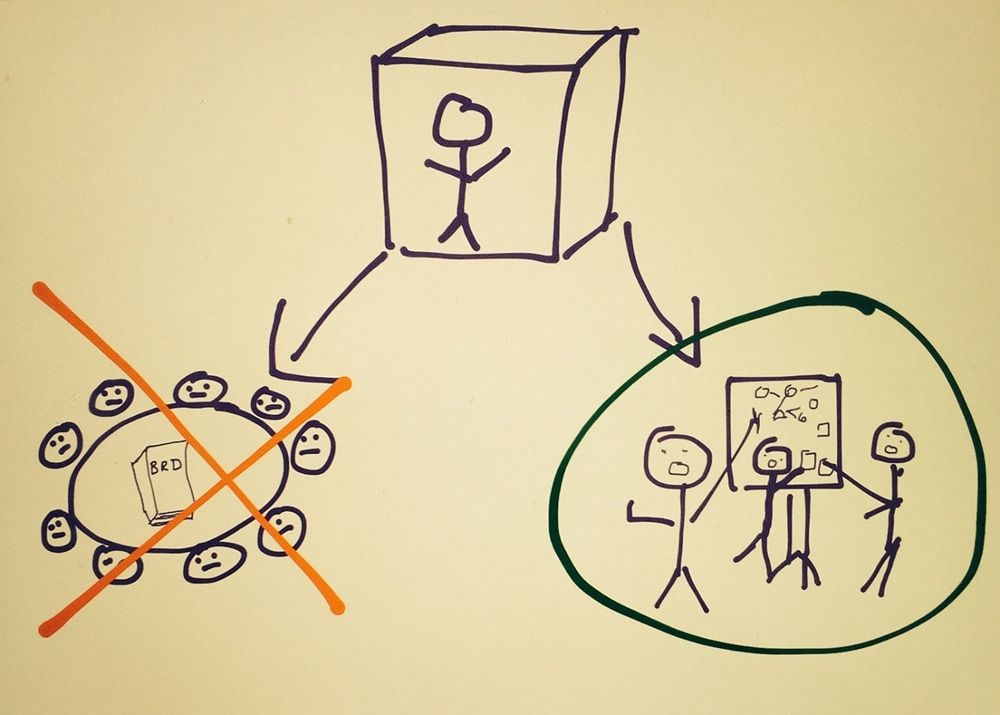Good Meetings create shared understanding, not BRDs!
Deliverables and artifacts were a focal point of BA work during the early part of my career. If I look back, it seemed the primary purpose of a BA was to generate paper—lots of paper—usually in the form of a giant BRD (business requirements document), and other related artifacts to support the Software Development Lifecycle and Project Management Process. As I grew in my career I realized my role as a BA was much more, and continued to evovle and struggle with the role of the template and paper.
As business and projects evolve, the primary purpose of the BA role is evolving too and increasingly has very little to do with paper! Not that agreed upon requirements are not important, please hear me out!
Many BAs still operate in a traditional environment where their requirements process flows like this:
- Gather requirements (usually in a large, 20+ person meeting, series of meetings, and interviews).
- Fill out requirements templates (usually alone in a cube).
- Send out the requirements document and schedule the sign off meeting
- Review requirements and hope for sign off (Another big meeting).
- Re-write requirements (usually alone in a cube).
- Review requirements (another big meeting, or send via email).
- Re-write requirements (usually alone in a cube).
- Harass and stalk many people until they re-read (probably not), and sign-off requirements.
Is it possible to achieve success using this approach? Maybe, but meetings like this are not effective and limiting your deliverables to a set of one-size-fits-all templates leaves too much room for gaps and errors.
In contrast, BAs who operate on teams with a more modern, flexible and collaborative approach operate under different expectations. They still need to perform standard BA functions and tasks, but with a different mindset and approach, this BA:
- Modifies their BA approach based on the unique needs of each project.
- Schedules small groups meetings to develop shared understanding
- Uses interactive, visual facilitation techniques to help the team discover and learn together.
- Produces only documentation needed by the team to move forward each day.
- Is okay adding visuals and models to the templates, and okay with using models and diagrams for the sole purpose of creating conversation, the diagram may or may not end up in a formally signed document.
- Delivers “shared understanding” instead of or with a BRD
Maybe the process would flow something like this:
- BA drafts a visual model.
- Team reviews and reacts and learns. (Update model collaboratively.)
- BA drafts additional visual models.
- Team reviews and reacts and learns. (Update models collaboratively.)
- BA documents only items needed by the team to move forward.
- Team weighs in on what is valuable for them to move forward.
- Team reviews and approves documentation. No surprises (or stalking) because the BA has developed SHARED UNDERSTANDING!
This scenario offers many benefits, including:
- Consistent collaboration: Collaboration happens throughout the process. Instead of the BA filing out requirements templates in solitary cube confinement, the team uses visual models to “write” the requirements collaboratively.
- Shared understanding: The BA does not “own” the requirements, the team does. The team shares an understanding of the value, goals and vision of the project. The shared understanding instills trust and confidence. The BA facilitates this process.
- Processing time: You have time between meetings to process, analyze, and find gaps and issues and constraints. You are able to bring up these questions and issues to the team, maybe create a visual to help the discussion along.
- Strategic Documentation: The requirements package changes for each project. Deliverables have a specific purpose and require much less rework if the shared understanding has been developed in advance!
As momentum swings toward this more flexible, just-in-time approach to requirements, how does the BA role change? How do we adapt? Which BA competencies become more important? If we aren’t supposed to be sitting in our cubes updating templates and generating paper, what should we be doing? What skills do we need to develop?
It may sounds simple, but as collaboration becomes the focus of project work, BAs really shine when they become expert meeting facilitators, conversation architects, and agents of change readiness.
These expert skills go beyond the basics of setting and agenda, keeping participants on task, tracking action items, and writing minutes. BAs with expert-level facilitation skills know how to:
- Use visual models to get conversations started and highlight gaps in shared understanding.
- Engage everyone using techniques that allow introverts and extroverts to contribute.
- Use interactive techniques that inspire people to engage physically.
- Make meetings efficient and valuable for all participants.
- Gather large amounts of information in a short amount of time.
- Create a collaborative environment face-to-face and virtually.
- Process and analyze the results of each collaboration session to make the next session productive, helping the team move steadily toward their goals.
Meeting time is so precious. Expert facilitators make the most of attendee time by building a shared understanding of value and purpose. It’s part of an Agile mindset that can and should be used in all project environments (traditional, Agile, and hybrid). Creating a shared conversation and shared understanding is more important than what’s on paper.
Honestly, shared understanding done well may mean a lot less documentation, you are the judge of how much documentation is valuable to the team.
So, how do BAs know when they have reached this level of shared understanding? Here are a few hints:
- People tell you! Eager stakeholders ready and willing to comment that they feel heard and are ready to move forward
- Stakeholders are not looking for or grasping for issues for the team to discuss, they feel confident the most important pieces are covered
- They feel they are reading a review of what was discussed when they review the final deliverable
- Stakeholder consistently contribute with an understanding of other stakeholder impacts and a big picture view of their needs
- When you “check in” with them on how the process is going, they enthusiastically are getting a lot out of the meetings and team interactions.
Using expert facilitation skills to reach a shared understanding with your team will lead to less defects and fewer enhancements. When BAs focus on learning and discovering, instead of just collecting and recording, they will boost their team’s ability to navigate complex change.
Don’t forget to leave your comments below.




